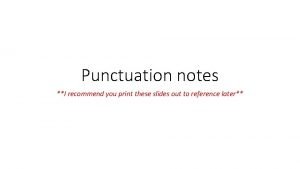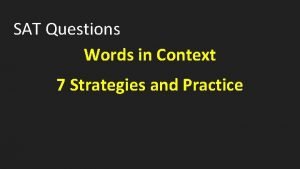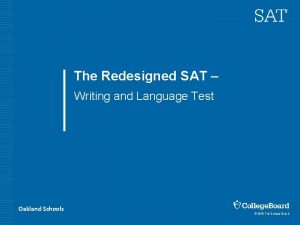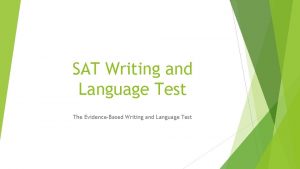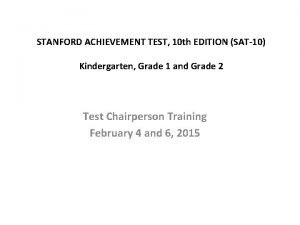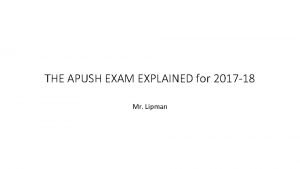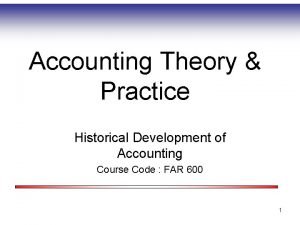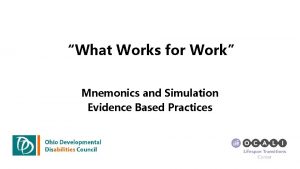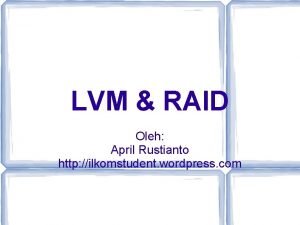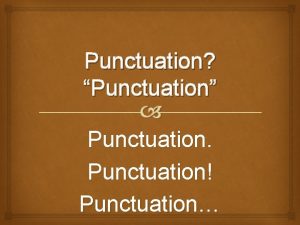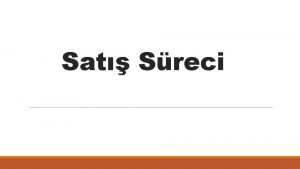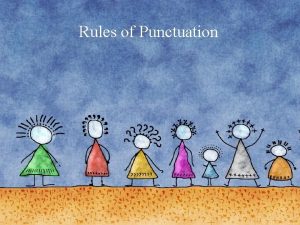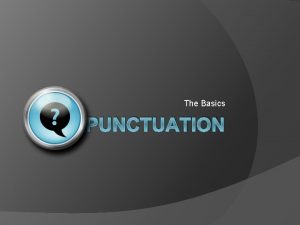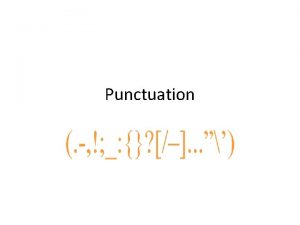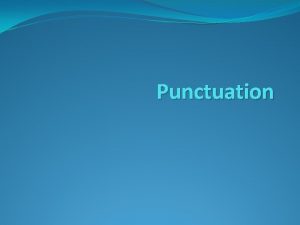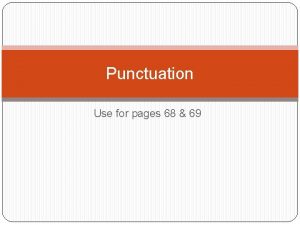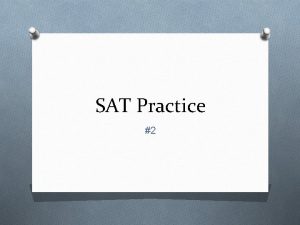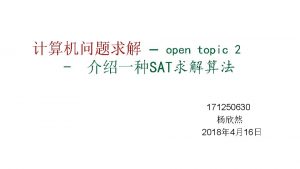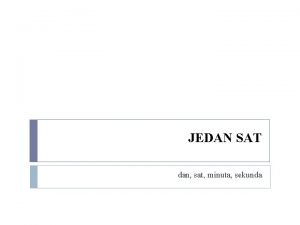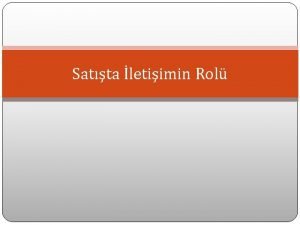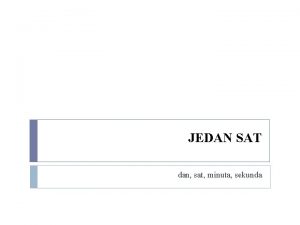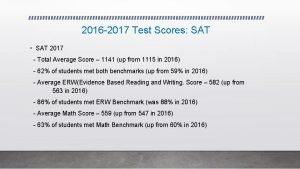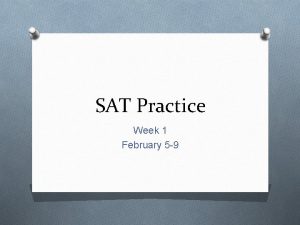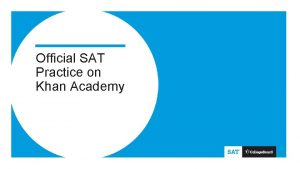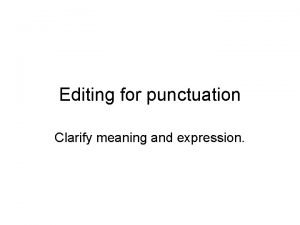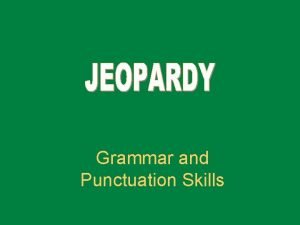SAT PRACTICE NOTES PUNCTUATION April 6 2017 PUNCTUATION

























- Slides: 25

SAT PRACTICE NOTES: PUNCTUATION April 6, 2017

PUNCTUATION QUESTIONS On the Writing and Language portion of the SAT, if you are unsure if punctuation is required, it is generally safer to choose the option leaving out punctuation. Only include commas, dashes, semicolons, or colons if you know the sentence needs them.

Looking at question 27, the comma before ‘that’ is not necessary. Be careful not to select an option that includes other types of unnecessary punctuation. In this example, answer D is the correct answer – no punctuation is needed in that section of the sentence.

COMMA RULES Surround non-restrictive clauses and appositives with commas. A portion of a sentence that can be removed without changing the meaning of the sentence must be surrounded by commas. Relative Clauses: Restrictive and Non-Restrictive Relative Clause: Dependent clauses that describe a noun and start with a relative pronoun or adverb like ‘who, ’ ‘that, ’ or ‘which. ’ Restrictive clauses generally should not be surrounded by commas while non-restrictive clauses should be. Restrictive Clause: essential to the meaning of the sentence, this clause cannot be removed without significantly changing the meaning of the sentence.

“People who sleep well are more alert. ” If you remove the clause “who sleep well, ” the meaning of the sentence would be different, leaving you with “People are more alert. ” Because removing the clause changes the meaning, the clause should not be surrounded by commas. Non-Restrictive Clause: is not essential to the meaning of the sentence – the sentence meaning would stay more or less the same without this clause. “Nate, who works as a software engineer, majored in computer science. While “who works as a software engineer” adds more detail and information, that clause is not essential to the meaning of the sentence and without it, the sentence would not be much different (“Nate majored in computer science”). Appositive: descriptive phrase that does not include a verb – similar to a non-restrictive clause, this can be removed without changing the meaning of the sentence. “Torsha, a fan of celebrity gossip, loves watching Keeping up with the Kardashians. ” Without the appositive underlined above, the meaning would stay the same.

If you’re uncertain about a phrase, eliminate it from the sentence. If the sentence still makes sense or has the same meaning, then the clause needs to be surrounded by commas. If the meaning is significantly different, then the clause does not need to include commas. This question is testing our knowledge on comma rules. The correct answer is C – there is no comma before the appositive in B and D has an unnecessary comma. The original (A) is missing a comma, therefore C is the correct answer.

COMMAS Use commas after an introductory phrase or clause. “In high school, Suzy was the class clown. ” “Although I want to go to Hawaii for Joe’s wedding, I have to work. ” If the sentence begins with a dependent clause or modifying phrase, it should be followed by a comma. Only a comma can follow an introductory phrase or clause that is not a complete thought.

The introductory phrase “Living…ethic” is not a complete thought (it cannot stand alone). The correct answer is D. B includes unnecessary punctuation, A is incorrect as the semicolon is not necessary, and C is incorrect because of the addition of the word “and. ”

COMMAS Commas separate items in a list. In a list of three or more items, commas must follow after every item with the exception of the last item. A comma before the last item is a series comma or an Oxford comma. “During spring break, my days will consist of eating, watching Netflix, and sleeping. ” “Participation in sports teaches many important values, including perseverance, teamwork, and dedication. ”

The correct answer is C.

COMMAS Do NOT use commas to separate complete thoughts. This creates a comma splice. “Dorothy failed her test, it was extremely difficult. ” Each of these clauses could stand alone and the comma is unnecessary. To correct a comma splice… …you can add a conjunction: “Dorothy failed her test, but it was extremely difficult. ” …add a relative pronoun: “Dorothy failed her test, which was extremely difficult. ” …use a semicolon or colon to separate the clauses: “Dorothy failed her test; it was extremely difficult. ”

The comma following instance is incorrect because the clauses on either side are complete thoughts. B is the correct answer. C is still a comma splice, A is still a comma splice, and D makes the connection to the list unclear. The colon should be used between the clauses because it is setting up a list.

COMMAS Do not use a comma between an adjective and a noun. “Trista bought a blue truck. ” – this is correct, there is no comma between blue and truck. “I enjoy reading the books of acclaimed writer Malcolm Gladwell. ” – no comma is needed after writer and before the writer’s name.

Since there should not be a comma between an adjective and a noun, the correct answer is D.

SEMI COLONS Semicolons are used to separate two complete thoughts. You should be able to swap a semicolon out with a period and have two separate sentences that make sense. “Jesse is my friend; I invited him to my party. ”

This semicolon in the sentence underlined is incorrect. It is separating two clauses that are not independent of one another. The answer D is correct.

COLONS Colons connect two independent clauses (clauses that can stand alone), but typically they are used to introduce lists or explanations. A colon must come after a complete sentence. As with a semicolon, you should be able to swap a period out for a colon and have two complete sentences. “Jasmine brought everything she needed for the exam: pencils, a backpack, and a calculator. ” “Sandy repeatedly complained about her least favorite restaurants: places where you can often hear loud conversations and crying babies. ”

The correct answer is D. We need punctuation to separate the complete thought up until “army” from the phrase elaborating on this group of people. Answer choice C is incorrect because the phrase following “army” isn’t a complete thought, and answer choice B is wrong because the dash before “by” is unnecessary.

DASHES Dashes can be used to mark off a non-essential clause or phrase (like a comma) or introduce a list or explanation (like a colon). You have to go with either two dashes or two commas. “Ryan—an energetic teenager—can’t sit still during class. ” OR “Ryan, an energetic teenager, can’t sit still during class. ”

Remember that you can’t mix dashes and commas when marking off nonessential phrases and clauses. Therefore, to maintain consistency, the correct answer is B.

QUESTION #1 Studies show that children; who are physically active may perform better in the classroom. A. NO CHANGE B. children, C. children D. children:

QUESTION #2 Last week, Theodore—who is an extremely conscientious student, won a $10, 000 scholarship; his parents are incredibly proud. A. NO CHANGE B. student—won C. student won D. student: won

QUESTION #3 Julie was thoroughly confused: she couldn’t figure out where she put her car keys. A. NO CHANGE B. confused, she C. confused she, D. confused she

QUESTION #4 Paul was overcome with joy when he saw actor, Keanu Reeves, in the parking lot of a Mc. Donald’s restaurant. A. NO CHANGE B. actor, Keanu Reeves C. actor: Keanu Reeves D. actor Keanu Reeves

QUESTION #5 I hurried home from school to find Max, my dog that I’ve had for five years chewing on my favorite pair of shoes. A. NO CHANGE B. had, for five years chewing C. had for five years, chewing D. had, for five, years chewing
 Sat punctuation practice
Sat punctuation practice Punctuation notes
Punctuation notes Sat 10 test
Sat 10 test Sat vocabulary lesson and practice lesson 4
Sat vocabulary lesson and practice lesson 4 Vocabulary in context sat practice questions
Vocabulary in context sat practice questions Standard english conventions sat practice
Standard english conventions sat practice When to use dashes sat
When to use dashes sat Psat score interpretation
Psat score interpretation Stanford achievement test kindergarten
Stanford achievement test kindergarten Stanford 10 test
Stanford 10 test 2017 apush exam
2017 apush exam 2017 ap chemistry practice exam
2017 ap chemistry practice exam 2017 asco oncology practice conference
2017 asco oncology practice conference Wisc
Wisc Accounting theory and practice notes
Accounting theory and practice notes Practice assessor and practice supervisor
Practice assessor and practice supervisor April 23 1564
April 23 1564 23.4.1616
23.4.1616 30 days has september april june and november
30 days has september april june and november April school activities
April school activities April 26 1564
April 26 1564 April savoy allstate
April savoy allstate 8 day week
8 day week Vårmåneder
Vårmåneder April rustianto
April rustianto Leonardo da vinci the last supper painting
Leonardo da vinci the last supper painting

